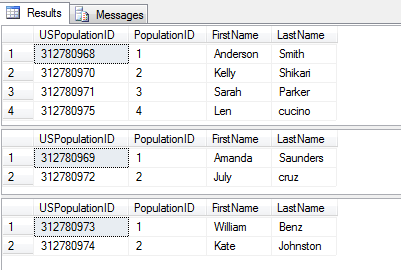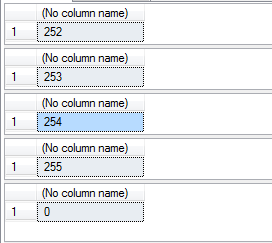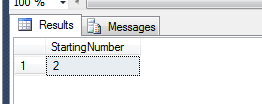One of the many features that Microsoft is introducing to the new SQL Server 2012 is Sequence object. In this article I am going to illustrate how to create and use the Sequence object.
Sequences generated by the Sequence object are similar to identity property values; however, it is not tied to one table.
Sequence object can be referenced by applications directly and can also be shared by many rows or many tables.
Creating the Sequence
Step 1
Let’s create a database where we can create the sequence object as shown below.
USE [master] GO DROP DATABASE [Lab_Sequence_Test] GO Create database Lab_Sequence_Test; GO
Step 2
Create a sequence object InvoiceNumber that would start the Invoice number from 1000 and increment by 5 every time the sequence object is accessed.
use Lab_Sequence_Test; GO Create SEQUENCE [dbo].[InvoiceNumber] as int START WITH 1000 INCREMENT BY 5;
Step 3
Now, the sequence value can be generated simply by using the NEXT VALUE FOR clause, as shown below.
SELECT NEXT VALUE FOR [dbo].[InvoiceNumber]
Result: 1000
You can generate the sequence with column name as shown below.
SELECT NEXT VALUE FOR [dbo].[InvoiceNumber] as SequenceValue
Result
Generate the sequence with column name
Step 4
The generated sequence can be used directly when inserting rows to a table as shown below.
USE [Lab_Sequence_Test] GO if (object_id('LLCInvoices') is not NULL) BEGIN DROP TABLE LLCInvoices END ELSE BEGIN CREATE TABLE [dbo].[LLCInvoices]( [InvoiceID] [int] NULL, [Name] [varchar](100) NULL ) ON [PRIMARY] END GO --Insert values Insert into LLCInvoices (InvoiceID, Name) VALUES (NEXT VALUE for [dbo].[InvoiceNumber],'Anderson') Insert into LLCInvoices (InvoiceID, Name) VALUES (NEXT VALUE for [dbo].[InvoiceNumber],'Neo') --Query Table Select * from LLCInvoices
Result
Inserting rows into a table
Step 5
Before accessing the NEXT VALUE of the sequence object, if you want to know the current value, you can access it by querying the DMV sys.sequences.
SELECT current_value FROM sys.sequences WHERE name = 'InvoiceNumber'
Result:
Querying the DMV
As I mentioned in the beginning of the article, the sequence can be shared by many tables. Let’s consider creating a sequence USPopulation that can be shared by all the US states.
Sharing Sequences
Step 1
Create the sequence for US Polulation.
Create SEQUENCE [dbo].[US_Population] as Bigint START WITH 312780968 INCREMENT BY 1;
Note: The sequence start is 312780968 (rough Current population)
Step2
Create tables for each state in the US. Here I am going to create tables for only the tristate area.
Create table NJ_Population (USPopulationID bigint, PopulationID bigint identity(1,1), FirstName varchar(100), LastName varchar(100)) Create table NY_Population (USPopulationID bigint, PopulationID bigint identity(1,1), FirstName varchar(100), LastName varchar(100)) Create table CT_Population (USPopulationID bigint, PopulationID bigint identity(1,1), FirstName varchar(100), LastName varchar(100))
Step3
Insert a few rows into each table simulating data for new borns in each state.
Insert into NJ_Population (USPopulationID, FirstName,LastName) VALUES (NEXT VALUE for [dbo].[US_Population],'Anderson', 'Smith') Insert into NY_Population (USPopulationID, FirstName,LastName) VALUES (NEXT VALUE for [dbo].[US_Population],'Amanda', 'Saunders') Insert into NJ_Population (USPopulationID, FirstName,LastName) VALUES (NEXT VALUE for [dbo].[US_Population],'Kelly', 'Shikari') Insert into NJ_Population (USPopulationID, FirstName,LastName) VALUES (NEXT VALUE for [dbo].[US_Population],'Sarah', 'Parker') Insert into NY_Population (USPopulationID, FirstName,LastName) VALUES (NEXT VALUE for [dbo].[US_Population],'July', 'cruz') Insert into CT_Population (USPopulationID, FirstName,LastName) VALUES (NEXT VALUE for [dbo].[US_Population],'William', 'Benz') Insert into CT_Population (USPopulationID, FirstName,LastName) VALUES (NEXT VALUE for [dbo].[US_Population],'Kate', 'Johnston') Insert into NJ_Population (USPopulationID, FirstName,LastName) VALUES (NEXT VALUE for [dbo].[US_Population],'Len', 'cucino')
Step 4
Let’s query all the 3 tristate area tables to examine the sequence numbers. From the output you can see that the sequence generated by the sequence object USPopulation is shared by all three tables and none of the tables have duplicate sequence values.
SELECT * from NJ_Population SELECT * from NY_Population SELECT * from CT_Population
Result
The sequence generated by the sequence object is shared by all three tables
Note: This article is written using SQL Server 2012 RC0 version.
The sequence generated by the sequence object can be recycled and the same sequence numbers can be re-generated using CYCLE as an argument when creating the sequence. The default option is NO CYCLE.
Recycling Sequences
Step 1
Let’s create the sequence object with a maximum value of 255 and that can be recycle again when generating sequence numbers.
Create SEQUENCE [dbo].[ReUsable_Sequence] as tinyint START WITH 252 INCREMENT BY 1 MINVALUE 0 MAXVALUE 255 CYCLE
Step 2
Let’s generate some sequence numbers and see if the generated number is recycled.
SELECT NEXT VALUE FOR [ReUsable_Sequence] SELECT NEXT VALUE FOR [ReUsable_Sequence] SELECT NEXT VALUE FOR [ReUsable_Sequence] SELECT NEXT VALUE FOR [ReUsable_Sequence] SELECT NEXT VALUE FOR [ReUsable_Sequence] SELECT NEXT VALUE FOR [ReUsable_Sequence]
Result:
See if the generated number is recycled
Step 3
The status of the sequence object can be viewed by querying the DMV sys.sequences as shown below.
SELECT Name,start_value,minimum_value,maximum_value ,current_value FROM sys.sequences WHERE name = 'ReUsable_Sequence'
Result:
The status of the sequence object
Sometimes it is necessary to get a range of sequence numbers for your application or object. For this, SQL Server provides a system stored procedure sp_sequence_get_range.
Let’s generate a range of 10 sequence numbers from the Sequence object Reusable_Sequence as shown below.
Example:
declare @range_first_value sql_variant declare @startingrangeout sql_variant declare @rangesize bigint set @rangesize =10 EXEC sp_sequence_get_range @sequence_name = N'dbo.ReUsable_Sequence', @range_size = @rangesize , @range_first_value= @startingrangeout OUTPUT ; SELECT @startingrangeout as StartingNumber
Result:
Generate a range of 10 sequence numbers
The status of the sequence object can be viewed by querying the DMV sys.sequences as shown below.
SELECT Name,start_value,minimum_value,maximum_value ,current_value FROM sys.sequences WHERE name = 'ReUsable_Sequence'
The status of the sequence object
As you can see, you can use the sequence numbers from 2 to 11 for your application.
To improve the performance of the Sequence object, SQL Server provides an option called CACHE; when used a range of value is cached in memory.
CREATE SEQUENCE MySeq AS int START WITH 2 INCREMENT BY 3 MINVALUE 2 MAXVALUE 500 CYCLE CACHE 10
In the above example, ten values will be cached in memory.
Conclusion
This article illustrated how to create a sequence object, generate sequence numbers, and how to use these generate numbers in inserting rows and sharing with many tables.










